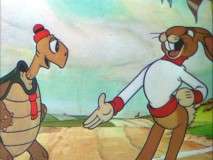The Tortoise and the Hare (film)
The Tortoise and the Hare is a 1935 American animated short film released on January 5, 1935 by United Artists, produced by Walt Disney and directed by Wilfred Jackson.[1] Based on an Aesop's fable of the same name, it won the 1934 Oscar for Best Short Subject: Cartoons. This cartoon is also believed to be one of the inspirations for Bugs Bunny, who first appeared in 1940.[2]
| The Tortoise and the Hare | |
|---|---|
 Toby Tortoise and Max Hare | |
| Directed by | Wilfred Jackson |
| Produced by | Walt Disney |
| Story by | Larry Clemmons |
| Starring | Pinto Colvig Eddie Holden Marcellite Garner |
| Music by | Darrell Calker Frank Churchill |
| Animation by | Kenneth Muse Ray Abrams Dick Lundy Don Patterson Louie Schmitt Dick Huemer Eric Larson Frenchy de Tremaudan Milt Schaffer |
| Color process | Technicolor |
Production company | |
| Distributed by | United Artists |
Release date |
|
Running time | 8 minutes 17 seconds |
| Language | English |
Plot
Max Hare is the heavy favorite to win a major sporting event---he's cocky, athletic and incredibly fast. His challenger, Toby Tortoise, is teased and jeered for being sluggish and clumsy. He does seem to have the ability to stretch, which comes in handy in certain situations. Max tells Toby that he intends to play fair, but it seems obvious that Max is just out to humiliate his competition. The race begins and Max zooms off. It takes an extra nudge from the starter to get Toby going.
Max seems to dominate the race, zooming past everything on the road. At one point, possibly as a homage to the fable, Max pretends to nap under a tree, just to watch Toby's progress. Thinking that Max really is asleep, Toby quietly creeps past him. Not long after, Max gets up and bolts past him again. A little further down the road, Max passes a girls' school, and stops to talk to the female bunnies. As Toby lumbers past, the girls invite him to stop as well, but Toby politely declines their offer, as he's committed to finishing the race. Even though Toby's now in the lead, Max opts to stay for a while, as he's confident that he'll have no trouble catching up with Toby because of how slow he is. Max uses the girls' sports field to show off his amazing athletic skills in archery, baseball and tennis.
Just then, Max hears the crowd cheering and sees that Toby is not far from the finish line. He bids the girls farewell and charges off, still confident that he will win easily. Toby sees Max catching up and picks up his pace by stretching his legs. In the end, the race is close. Max crosses the finish line and skids to a rough halt. Once he gets up and dusts himself off, he realizes that he lost by a "neck's length." The crowd rushes to congratulate the winner: Toby Tortoise.
Other appearances
Toby Tortoise and Max Hare reappear in the 1936 cartoon short Toby Tortoise Returns.
The Silly Symphony Sunday comic strip ran a two-month-long sequence called "The Boarding-School Mystery" from December 23, 1934 to February 17, 1935, featuring Toby Tortoise and Max Hare.[3]
The girl bunnies and the animal pedestrians make cameos in Toontown, while Toby Tortoise is on a poster in the Toontown alleyway and appears during the final scene of the 1988 film Who Framed Roger Rabbit. Toby and Max also appear as guests in the 2001-2003 series Disney's House of Mouse. Toby and Max make brief non-speaking cameos in the Mickey Mouse short "Carried Away".
Voice cast
- Tortoise: Eddie Holden
- Hare: Ned Norton
- Starter: Pinto Colvig
- Girl Bunny #1: Dorothy Compton
- Girl Bunny #2: Mary Moder
- Girl Bunny #3: Beatrice Hagen
- Miss Cottontail girl: Marcellite Garner[1]
Home media
The short was released on the 2001 Walt Disney Treasures DVD box set Silly Symphonies.[1]
References
- Merritt, Russell; Kaufman, J. B. (2016). Walt Disney's Silly Symphonies: A Companion to the Classic Cartoon Series (2nd ed.). Glendale, CA: Disney Editions. pp. 154–155. ISBN 978-1-4847-5132-9.
- Barrier (2003), p. 359-362
- Duvall, Earl; Taliaferro, Al; Osborne, Ted; De Maris, Merrill (2016). Silly Symphonies: The Complete Disney Classics, vol 1. San Diego: IDW Publishing. ISBN 978-1631405587.
- Barrier, Michael (2003). "Warner Bros., 1933-1940". Hollywood Cartoons : American Animation in Its Golden Age: American Animation in Its Golden Age. Oxford University Press. ISBN 9780198020790.
External links
| Wikiquote has quotations related to: The Tortoise and the Hare (film) |